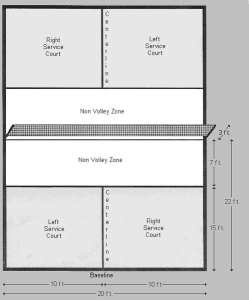Sandy Pickle Answers:
How To Play Pickleball
If you’ve found this page, you may have been looking for information on how to play pickleball. Shortly before we came up with Sandy Pickle, we ourselves had just been introduced to pickleball. Although we now play our game more often, we still get out to the pickleball courts and would be happy to help answer some of your questions about America’s fastest growing sport!
Pickleball History, Overview & Simplified Rules
A Beginner’s Guide To Pickleball (In Layman’s Terms)
1. What Is Pickleball?
Although its widespread popularity is relatively recent, the game of pickleball was actually invented in 1965 on Bainbridge Island near Seattle, Washington by former congressman Joel Pritchard and his golf buddy Bill Bell. The two had just returned to Pritchard’s home from playing a round of golf to find their families sitting around in boredom. There was an old badminton court on the property so they proposed a game, but the only equipment they could find were some ping pong paddles and a whiffle ball.
Now this is an ironic point in history for us at Sandy Pickle headquarters, because with a badminton net height of 60 inches, flat surface paddles and a perforated plastic ball, they played an all-volley game over the net. Sound familiar? As they played throughout the weekend, they realized that the ball bounced well on the badminton court and decided to lower the net to 36″ and let the ball bounce between shots, similar to tennis. The next weekend, another friend named Barney McCallum joined the game and the three men created rules, likely borrowing what seemed most relevant from badminton, tennis, and ping pong rules.
Two years later in 1967, the first permanent pickleball court was built in the backyard of Joel Pritchard’s friend and neighbor, Bob O’Brian.
In 1972 the creators formed a corporation to formalize the sport they called pickleball. During the next several years, pickleball grew mostly within the state of Washington, but news began spreading, most notably through articles published in The National Observer and Tennis Magazine, calling pickleball “America’s newest racquet sport”, and a section in a book published in 1978 called “The Other Raquet Sports”.
In 1982, a man named Sid Williams entered the pickleball picture, organizing tournaments, and in 1984 he led creation of The United States Amateur Pickleball Association (U.S.A.P.A.) and its first official rulebook.
This section is supposed to be an overview, but we went a little deeper on the history mostly because it reminded us of our own journey as the creators of Sandy Pickle. If your appetite for more details on the history and growth of pickleball, here are a few interesting research topics:
History of the USAPA
Pickleball Pioneers Sid Williams, Frank Candelario, Arlen Paranto and more
Pickleball ball manufacturer Pickle-Ball, Inc.
“Pickleball Stuff” Website launch
Current pickleball industry business leaders
Top Pickleball players from the original rankings through today
Pickleball’s popularity among senior citizens & key elements of its gradual transition to mainstream popularity
APP & PPA Tours
Major League Pickleball (MLP) vs Professional Pickleball Association (PPA)
2. The Parts of a Pickleball Court
As you drive by local parks, you may have noticed that what used to be tennis courts are now crowded with people playing pickleball (which happens to be the fastest growing game in America). The court itself looks similar to a tennis court, only smaller.
 Before you start playing, it’s a good idea to know the “parts” of a pickleball court. The boundaries are self-explanatory…anything inside the perimeter lines is in play (including the lines themselves should the ball land on them). These are called the “Sidelines” and “Baselines”. There is also a “centerline” on each side that divides the left and right sides of the playing surface, marking the left and right “Service Areas” (see serving details below), but there is also a line between these rectangular playing areas and the net that doesn’t exist in tennis. This is a very important line…it’s called the “Kitchen” or “Non-Volley Zone”, which will also be explained below.
Before you start playing, it’s a good idea to know the “parts” of a pickleball court. The boundaries are self-explanatory…anything inside the perimeter lines is in play (including the lines themselves should the ball land on them). These are called the “Sidelines” and “Baselines”. There is also a “centerline” on each side that divides the left and right sides of the playing surface, marking the left and right “Service Areas” (see serving details below), but there is also a line between these rectangular playing areas and the net that doesn’t exist in tennis. This is a very important line…it’s called the “Kitchen” or “Non-Volley Zone”, which will also be explained below.
You don’t really need to know the dimensions in order to play the game, but it’s always impressive when you know more than an avid pickleball player, so here you go:
- The official pickleball court width is 20 feet
- The distance from the net to the baseline on each side of the court is 22 feet
- Each “service area” is 10 feet wide and 15 feet long.
- The Kitchen runs between the sideline boundaries exactly 7 feet or 2.1336 meters from the net (we just threw in the metric measurements as extra credit – and to prove that this game was definitely invented in the United States). And in case you aren’t great at math, the Kitchen is also 20 feet wide.
- A regulation net height is 36 inches on each sideline, dipping slightly to 34 inches in the center.
And now you’re ready for some basic rules…continue on!
3. Number of Players & Categories of Competition
Pickleball can be played both as an individual and as a 2-person team sport and within age, gender, skill level and co-ed categories of competition. In order to simplify the rules below, the focus will be on recreational doubles team play, which is the most common.
Regardless of singles, doubles, or classification, the court size is the same (unlike tennis which has a wider playing area for doubles).
4. Non-Volley Zone (most often referred to as the Kitchen)
The Kitchen area on each side is the most unique and respected part of a pickleball court. If you and/or your kids have ever played “The Floor Is Lava”, its a lot like that, but slightly less scary. Stepping into this area to make a play on the ball, including follow-through, is a fault and the point is over UNLESS the ball has bounced within the kitchen before you hit it back. Oh, and why less scary? The kitchen is only lava if you are making a play on the ball. Unless you are making a play on the ball, it is perfectly legal to step into, dance on, crawl in, lick, and do a headstand without getting burned.
*Note that in Pickleball you can reach over the kitchen line to make a play on the ball, as long as no part of your body touches the “lava”. In Sandy Pickle, the no-spike zone includes the vertical area above the line, and although you can enter at any time, the contact between your paddle and ball must not be higher than the top of the net.
5. Games & Matches
A standard pickleball match is the best of 3 games, and each game is played to 11 (or higher in a close game; you must win by 2). Teams rotate sides at end of the first two games, and at 5 point intervals if the first two games are split and a third game is required. Points are only earned by the serving team when they win a rally, so if you thought 11 points doesn’t sound like enough, the number of rallys involved in reaching a winning score is much higher.
We’ll leave the scoring simple and move on to the serving section to throw the rulebook at you.
6. Serving & Scoring
This is without argument the most confusing section of the rule book, but absolutely required knowledge if you want to start playing pickleball regularly. Rather than presenting the information in essay format, it is more easily digested in bullet-points, and don’t worry, your friends will help remind you what you have forgotten after reading through this cheat-sheet:
Points are only earned by the serving team when they win a rally.
Each server begins their turn serving from behind the right side of their baseline, and continues serving until they lose a rally, alternating between left and right sides of the baseline with each point won (and serving diagonally to the corresponding service court on the opponent’s side).
The opportunity to serve alternates players each time the current server’s point is lost. In pickleball, both teammates get a chance to serve before the opportunity moves to the opposing team (except for on the first point of each new game).
When calling out the score, start with your team’s score (for example pretend you have 9 points), then your opponent’s score (you’re so good, let’s say they only have 4 points), and THEN the number of which turn you are on (let’s say your partner was the first to serve on your team, which makes you server 2). The score would be called out before you serve as “9-4-2” (your score, their score, and who’s turn it is).
When the second server on a team loses the point, the serve moves to the opposite side, and whichever player is on the right-hand side of the court takes the first turn (opposing teams should not alternate to left or right sides of their court except for when they win a point and move for the next serve; both players should remain on whichever side they were on when they lost the second servers turn until the serve returns back to their side again.
For serving technique, please consider a lesson, just know that you may not serve overhead as you do in tennis. The paddle and ball contact should be below waist level on each serve; serving is not generally considered an offensive weapon and is always done underhand. You may drop the ball and let it bounce, or hit it immediately before it falls.
Both players on the serving side must wait until after the opposing team’s return shot has bounced again on their side of the net before their next hit (Double Bounce Rule).
7. Miscellaneous Stuff
A shot is considered “in” when it bounces on a line.
If the serve hits the net and continues into the intended service court side and bounces on or beyond the kitchen line, it is a playable serve.
If the serve does not clear the kitchen, the point is lost.
When playing a ball inside the kitchen, no part of your body or equipment may touch the net
Nobody likes an A-hole. Be a good sport. Pickleball has become more competitive, but letting your drive to win become abrasive cab quickly give you a reputation within your pickleball community that you don’t want to have. Just ask some of the A-holes at our local club :)


